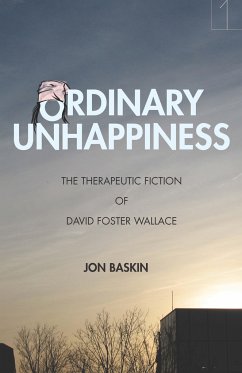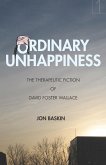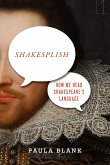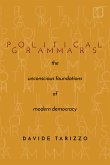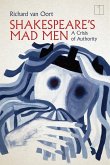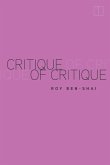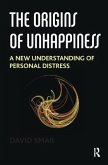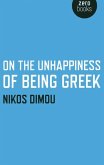- Gebundenes Buch
- Merkliste
- Auf die Merkliste
- Bewerten Bewerten
- Teilen
- Produkt teilen
- Produkterinnerung
- Produkterinnerung
This book approaches David Foster Wallace not only as a fiction writer but also as a cultural critic and a moral philosopher whose formal innovations were intended as "therapies" for the pervasive dis-eases of our time.
Andere Kunden interessierten sich auch für
![Ordinary Unhappiness Ordinary Unhappiness]() Jon BaskinOrdinary Unhappiness27,99 €
Jon BaskinOrdinary Unhappiness27,99 €![Shakesplish Shakesplish]() Paula BlankShakesplish34,99 €
Paula BlankShakesplish34,99 €![Political Grammars Political Grammars]() Davide TarizzoPolitical Grammars36,99 €
Davide TarizzoPolitical Grammars36,99 €![Shakespeare's Mad Men Shakespeare's Mad Men]() Richard van OortShakespeare's Mad Men36,99 €
Richard van OortShakespeare's Mad Men36,99 €![Critique of Critique Critique of Critique]() Roy Ben-ShaiCritique of Critique34,99 €
Roy Ben-ShaiCritique of Critique34,99 €![The Origins of Unhappiness The Origins of Unhappiness]() David SmailThe Origins of Unhappiness23,99 €
David SmailThe Origins of Unhappiness23,99 €![On the Unhappiness of Being Greek On the Unhappiness of Being Greek]() Nikos DimouOn the Unhappiness of Being Greek10,99 €
Nikos DimouOn the Unhappiness of Being Greek10,99 €-
-
-
This book approaches David Foster Wallace not only as a fiction writer but also as a cultural critic and a moral philosopher whose formal innovations were intended as "therapies" for the pervasive dis-eases of our time.
Hinweis: Dieser Artikel kann nur an eine deutsche Lieferadresse ausgeliefert werden.
Hinweis: Dieser Artikel kann nur an eine deutsche Lieferadresse ausgeliefert werden.
Produktdetails
- Produktdetails
- Square One: First-Order Questions in the Humanities
- Verlag: Stanford University Press
- Seitenzahl: 200
- Erscheinungstermin: 6. August 2019
- Englisch
- Abmessung: 223mm x 146mm x 20mm
- Gewicht: 394g
- ISBN-13: 9781503608337
- ISBN-10: 1503608336
- Artikelnr.: 53536863
- Herstellerkennzeichnung
- Libri GmbH
- Europaallee 1
- 36244 Bad Hersfeld
- gpsr@libri.de
- Square One: First-Order Questions in the Humanities
- Verlag: Stanford University Press
- Seitenzahl: 200
- Erscheinungstermin: 6. August 2019
- Englisch
- Abmessung: 223mm x 146mm x 20mm
- Gewicht: 394g
- ISBN-13: 9781503608337
- ISBN-10: 1503608336
- Artikelnr.: 53536863
- Herstellerkennzeichnung
- Libri GmbH
- Europaallee 1
- 36244 Bad Hersfeld
- gpsr@libri.de
Jon Baskin is the Associate Director of the Creative Publishing and Critical Journalism program at the New School for Social Research and a founding editor of The Point.
Contents and Abstracts
Introduction: Habits of Mind
chapter abstract
This chapter begins by briefly recounting the substance of the "ancient
quarrel" between poetry and philosophy, before laying out the central
convictions of Wallace's "philosophical" fiction, partly through reading a
central passage in Wittgenstein's Investigations. Some of the main features
of Wallace's project are addressed through an interpretation of his early
short story "The Planet Trillaphon as It Stands in Relation to the Bad
Thing," about a boy battling clinical depression. The next section
discusses the current state of "Wallace Studies," particularly through Adam
Kelly's essay on Wallace and sincerity. It concludes with a case for how
recent discussions about Wallace's biography and character should lead us
to reexamine his books.
1Narrative Morality: On Philosophically Therapeutic Criticism
chapter abstract
This chapter explores and attempts to justify a philosophically therapeutic
approach to imaginative literature. It does so by tracing attempts both in
literary studies and moral philosophy to move beyond disciplinary binaries
and show how philosophy and literature can interact. Particularly, it
focuses on the approaches to literature of three philosophers-Iris Murdoch,
Robert Pippin, and Stanley Cavell-and one literary critic: Toril Moi.
Through these figures it lays out criteria for successful therapeutic
criticism, including how the therapeutic critic should relate to past
critics of the same work. It argues that one role of the therapeutic critic
is to understand why previous critics have not seen what is "obvious" in
the work of art under discussion.
2Playing Games: Infinite Jest as Philosophical Therapy
chapter abstract
This chapter offers a reading of Wallace's mid-career masterpiece, Infinite
Jest. Central to the reading is the juxtaposition of the novel's opening
scene-of Hal Incandenza sitting unable to communicate in a college
admissions meeting-and its closing scene-of the Alcoholics Anonymous
orderly Don Gately lying on a hospital bed with a tube down his throat.
Bookended by these scenes, the chapter argues that Wallace's book is
structured as a therapeutic intervention into the way we think about
communication and self-expression. Central to this argument is the ability
to see the sections on Alcoholics Anonymous as the book's moral and
philosophical center. It posits the goal of the book as being to bring its
readers back from the "hysteria" of metaphysical theory to the "everyday"
problems of ordinary unhappiness.
3So Decide: Brief Interviews with Hideous Men as Philosophical Criticism
chapter abstract
Wallace's most controversial collection of short stories has been accused
since its inception of being misogynistic or self-indulgent-a charge that
has only gotten more severe as a result of recent indications about
Wallace's own treatment of women. The chapter argues, through one of the
few readings that accounts for how the collection of stories work together,
that misunderstandings of the book rest on a failure to appreciate its
strategy of therapeutic "aggravation." The book seeks to exhaust the reader
with its characters' various justifications for their misogyny and
self-indulgence-which is what truly marks them, rather than their (fairly
common) misogynistic behavior, as "hideous." The collection is
philosophical in the sense that it exposes hideousness as the function of a
certain way of speaking and therefore of a certain form of life.
4Untrendy Problems: The Pale King's Philosophical Inspirations
chapter abstract
This chapter interprets Wallace's final, unfinished novel, The Pale King,
as a dialogue between two forms of philosophical procedure: Wittgenstein's
therapeutic philosophy and Stanley Cavell's perfectionism. The book
represents a new stage in Wallace's project insofar as it endeavors to go
beyond negative therapy to positive inspiration. Wallace is on shakier
ground here, and perhaps his attempt to portray "maturity" positively in
fiction was responsible for his difficulty finishing the book. It is also
indicative of a moralism that he mostly holds at bay in his earlier
writing. Still, detractors who point to the novel as like "self-help"
reinforce the hard distinction between philosophy and self-help or therapy
that Wallace takes aim at throughout his fiction. If aspects of The Pale
King can be usefully compared to self-help or "books of affirmations," the
novel also seeks to demonstrate why its readers are in need of such help.
Conclusion: In Heaven and Earth
chapter abstract
This chapter explains why Wallace's fiction was a promising candidate for
the philosophically therapeutic approach, while also drawing a distinction
between art that has a philosophical ambition and art that wants something
else. This "something else"-or, as Hamlet calls it, "more"-that art does is
the reason that Plato had banished artists from his Republic. Cavell's
perfectionism was an attempt to show that Plato had been wrong and that
philosophy and art can be united in a common project. But Cavell's reading
of Hamlet unwittingly shows the limitations of this commonality. The
chapter thus seeks both to state the ultimate aspiration of the therapeutic
project and to show where and how its boundaries lie. Not all differences
between art and philosophy can or should be bridged.
Introduction: Habits of Mind
chapter abstract
This chapter begins by briefly recounting the substance of the "ancient
quarrel" between poetry and philosophy, before laying out the central
convictions of Wallace's "philosophical" fiction, partly through reading a
central passage in Wittgenstein's Investigations. Some of the main features
of Wallace's project are addressed through an interpretation of his early
short story "The Planet Trillaphon as It Stands in Relation to the Bad
Thing," about a boy battling clinical depression. The next section
discusses the current state of "Wallace Studies," particularly through Adam
Kelly's essay on Wallace and sincerity. It concludes with a case for how
recent discussions about Wallace's biography and character should lead us
to reexamine his books.
1Narrative Morality: On Philosophically Therapeutic Criticism
chapter abstract
This chapter explores and attempts to justify a philosophically therapeutic
approach to imaginative literature. It does so by tracing attempts both in
literary studies and moral philosophy to move beyond disciplinary binaries
and show how philosophy and literature can interact. Particularly, it
focuses on the approaches to literature of three philosophers-Iris Murdoch,
Robert Pippin, and Stanley Cavell-and one literary critic: Toril Moi.
Through these figures it lays out criteria for successful therapeutic
criticism, including how the therapeutic critic should relate to past
critics of the same work. It argues that one role of the therapeutic critic
is to understand why previous critics have not seen what is "obvious" in
the work of art under discussion.
2Playing Games: Infinite Jest as Philosophical Therapy
chapter abstract
This chapter offers a reading of Wallace's mid-career masterpiece, Infinite
Jest. Central to the reading is the juxtaposition of the novel's opening
scene-of Hal Incandenza sitting unable to communicate in a college
admissions meeting-and its closing scene-of the Alcoholics Anonymous
orderly Don Gately lying on a hospital bed with a tube down his throat.
Bookended by these scenes, the chapter argues that Wallace's book is
structured as a therapeutic intervention into the way we think about
communication and self-expression. Central to this argument is the ability
to see the sections on Alcoholics Anonymous as the book's moral and
philosophical center. It posits the goal of the book as being to bring its
readers back from the "hysteria" of metaphysical theory to the "everyday"
problems of ordinary unhappiness.
3So Decide: Brief Interviews with Hideous Men as Philosophical Criticism
chapter abstract
Wallace's most controversial collection of short stories has been accused
since its inception of being misogynistic or self-indulgent-a charge that
has only gotten more severe as a result of recent indications about
Wallace's own treatment of women. The chapter argues, through one of the
few readings that accounts for how the collection of stories work together,
that misunderstandings of the book rest on a failure to appreciate its
strategy of therapeutic "aggravation." The book seeks to exhaust the reader
with its characters' various justifications for their misogyny and
self-indulgence-which is what truly marks them, rather than their (fairly
common) misogynistic behavior, as "hideous." The collection is
philosophical in the sense that it exposes hideousness as the function of a
certain way of speaking and therefore of a certain form of life.
4Untrendy Problems: The Pale King's Philosophical Inspirations
chapter abstract
This chapter interprets Wallace's final, unfinished novel, The Pale King,
as a dialogue between two forms of philosophical procedure: Wittgenstein's
therapeutic philosophy and Stanley Cavell's perfectionism. The book
represents a new stage in Wallace's project insofar as it endeavors to go
beyond negative therapy to positive inspiration. Wallace is on shakier
ground here, and perhaps his attempt to portray "maturity" positively in
fiction was responsible for his difficulty finishing the book. It is also
indicative of a moralism that he mostly holds at bay in his earlier
writing. Still, detractors who point to the novel as like "self-help"
reinforce the hard distinction between philosophy and self-help or therapy
that Wallace takes aim at throughout his fiction. If aspects of The Pale
King can be usefully compared to self-help or "books of affirmations," the
novel also seeks to demonstrate why its readers are in need of such help.
Conclusion: In Heaven and Earth
chapter abstract
This chapter explains why Wallace's fiction was a promising candidate for
the philosophically therapeutic approach, while also drawing a distinction
between art that has a philosophical ambition and art that wants something
else. This "something else"-or, as Hamlet calls it, "more"-that art does is
the reason that Plato had banished artists from his Republic. Cavell's
perfectionism was an attempt to show that Plato had been wrong and that
philosophy and art can be united in a common project. But Cavell's reading
of Hamlet unwittingly shows the limitations of this commonality. The
chapter thus seeks both to state the ultimate aspiration of the therapeutic
project and to show where and how its boundaries lie. Not all differences
between art and philosophy can or should be bridged.
Contents and Abstracts
Introduction: Habits of Mind
chapter abstract
This chapter begins by briefly recounting the substance of the "ancient
quarrel" between poetry and philosophy, before laying out the central
convictions of Wallace's "philosophical" fiction, partly through reading a
central passage in Wittgenstein's Investigations. Some of the main features
of Wallace's project are addressed through an interpretation of his early
short story "The Planet Trillaphon as It Stands in Relation to the Bad
Thing," about a boy battling clinical depression. The next section
discusses the current state of "Wallace Studies," particularly through Adam
Kelly's essay on Wallace and sincerity. It concludes with a case for how
recent discussions about Wallace's biography and character should lead us
to reexamine his books.
1Narrative Morality: On Philosophically Therapeutic Criticism
chapter abstract
This chapter explores and attempts to justify a philosophically therapeutic
approach to imaginative literature. It does so by tracing attempts both in
literary studies and moral philosophy to move beyond disciplinary binaries
and show how philosophy and literature can interact. Particularly, it
focuses on the approaches to literature of three philosophers-Iris Murdoch,
Robert Pippin, and Stanley Cavell-and one literary critic: Toril Moi.
Through these figures it lays out criteria for successful therapeutic
criticism, including how the therapeutic critic should relate to past
critics of the same work. It argues that one role of the therapeutic critic
is to understand why previous critics have not seen what is "obvious" in
the work of art under discussion.
2Playing Games: Infinite Jest as Philosophical Therapy
chapter abstract
This chapter offers a reading of Wallace's mid-career masterpiece, Infinite
Jest. Central to the reading is the juxtaposition of the novel's opening
scene-of Hal Incandenza sitting unable to communicate in a college
admissions meeting-and its closing scene-of the Alcoholics Anonymous
orderly Don Gately lying on a hospital bed with a tube down his throat.
Bookended by these scenes, the chapter argues that Wallace's book is
structured as a therapeutic intervention into the way we think about
communication and self-expression. Central to this argument is the ability
to see the sections on Alcoholics Anonymous as the book's moral and
philosophical center. It posits the goal of the book as being to bring its
readers back from the "hysteria" of metaphysical theory to the "everyday"
problems of ordinary unhappiness.
3So Decide: Brief Interviews with Hideous Men as Philosophical Criticism
chapter abstract
Wallace's most controversial collection of short stories has been accused
since its inception of being misogynistic or self-indulgent-a charge that
has only gotten more severe as a result of recent indications about
Wallace's own treatment of women. The chapter argues, through one of the
few readings that accounts for how the collection of stories work together,
that misunderstandings of the book rest on a failure to appreciate its
strategy of therapeutic "aggravation." The book seeks to exhaust the reader
with its characters' various justifications for their misogyny and
self-indulgence-which is what truly marks them, rather than their (fairly
common) misogynistic behavior, as "hideous." The collection is
philosophical in the sense that it exposes hideousness as the function of a
certain way of speaking and therefore of a certain form of life.
4Untrendy Problems: The Pale King's Philosophical Inspirations
chapter abstract
This chapter interprets Wallace's final, unfinished novel, The Pale King,
as a dialogue between two forms of philosophical procedure: Wittgenstein's
therapeutic philosophy and Stanley Cavell's perfectionism. The book
represents a new stage in Wallace's project insofar as it endeavors to go
beyond negative therapy to positive inspiration. Wallace is on shakier
ground here, and perhaps his attempt to portray "maturity" positively in
fiction was responsible for his difficulty finishing the book. It is also
indicative of a moralism that he mostly holds at bay in his earlier
writing. Still, detractors who point to the novel as like "self-help"
reinforce the hard distinction between philosophy and self-help or therapy
that Wallace takes aim at throughout his fiction. If aspects of The Pale
King can be usefully compared to self-help or "books of affirmations," the
novel also seeks to demonstrate why its readers are in need of such help.
Conclusion: In Heaven and Earth
chapter abstract
This chapter explains why Wallace's fiction was a promising candidate for
the philosophically therapeutic approach, while also drawing a distinction
between art that has a philosophical ambition and art that wants something
else. This "something else"-or, as Hamlet calls it, "more"-that art does is
the reason that Plato had banished artists from his Republic. Cavell's
perfectionism was an attempt to show that Plato had been wrong and that
philosophy and art can be united in a common project. But Cavell's reading
of Hamlet unwittingly shows the limitations of this commonality. The
chapter thus seeks both to state the ultimate aspiration of the therapeutic
project and to show where and how its boundaries lie. Not all differences
between art and philosophy can or should be bridged.
Introduction: Habits of Mind
chapter abstract
This chapter begins by briefly recounting the substance of the "ancient
quarrel" between poetry and philosophy, before laying out the central
convictions of Wallace's "philosophical" fiction, partly through reading a
central passage in Wittgenstein's Investigations. Some of the main features
of Wallace's project are addressed through an interpretation of his early
short story "The Planet Trillaphon as It Stands in Relation to the Bad
Thing," about a boy battling clinical depression. The next section
discusses the current state of "Wallace Studies," particularly through Adam
Kelly's essay on Wallace and sincerity. It concludes with a case for how
recent discussions about Wallace's biography and character should lead us
to reexamine his books.
1Narrative Morality: On Philosophically Therapeutic Criticism
chapter abstract
This chapter explores and attempts to justify a philosophically therapeutic
approach to imaginative literature. It does so by tracing attempts both in
literary studies and moral philosophy to move beyond disciplinary binaries
and show how philosophy and literature can interact. Particularly, it
focuses on the approaches to literature of three philosophers-Iris Murdoch,
Robert Pippin, and Stanley Cavell-and one literary critic: Toril Moi.
Through these figures it lays out criteria for successful therapeutic
criticism, including how the therapeutic critic should relate to past
critics of the same work. It argues that one role of the therapeutic critic
is to understand why previous critics have not seen what is "obvious" in
the work of art under discussion.
2Playing Games: Infinite Jest as Philosophical Therapy
chapter abstract
This chapter offers a reading of Wallace's mid-career masterpiece, Infinite
Jest. Central to the reading is the juxtaposition of the novel's opening
scene-of Hal Incandenza sitting unable to communicate in a college
admissions meeting-and its closing scene-of the Alcoholics Anonymous
orderly Don Gately lying on a hospital bed with a tube down his throat.
Bookended by these scenes, the chapter argues that Wallace's book is
structured as a therapeutic intervention into the way we think about
communication and self-expression. Central to this argument is the ability
to see the sections on Alcoholics Anonymous as the book's moral and
philosophical center. It posits the goal of the book as being to bring its
readers back from the "hysteria" of metaphysical theory to the "everyday"
problems of ordinary unhappiness.
3So Decide: Brief Interviews with Hideous Men as Philosophical Criticism
chapter abstract
Wallace's most controversial collection of short stories has been accused
since its inception of being misogynistic or self-indulgent-a charge that
has only gotten more severe as a result of recent indications about
Wallace's own treatment of women. The chapter argues, through one of the
few readings that accounts for how the collection of stories work together,
that misunderstandings of the book rest on a failure to appreciate its
strategy of therapeutic "aggravation." The book seeks to exhaust the reader
with its characters' various justifications for their misogyny and
self-indulgence-which is what truly marks them, rather than their (fairly
common) misogynistic behavior, as "hideous." The collection is
philosophical in the sense that it exposes hideousness as the function of a
certain way of speaking and therefore of a certain form of life.
4Untrendy Problems: The Pale King's Philosophical Inspirations
chapter abstract
This chapter interprets Wallace's final, unfinished novel, The Pale King,
as a dialogue between two forms of philosophical procedure: Wittgenstein's
therapeutic philosophy and Stanley Cavell's perfectionism. The book
represents a new stage in Wallace's project insofar as it endeavors to go
beyond negative therapy to positive inspiration. Wallace is on shakier
ground here, and perhaps his attempt to portray "maturity" positively in
fiction was responsible for his difficulty finishing the book. It is also
indicative of a moralism that he mostly holds at bay in his earlier
writing. Still, detractors who point to the novel as like "self-help"
reinforce the hard distinction between philosophy and self-help or therapy
that Wallace takes aim at throughout his fiction. If aspects of The Pale
King can be usefully compared to self-help or "books of affirmations," the
novel also seeks to demonstrate why its readers are in need of such help.
Conclusion: In Heaven and Earth
chapter abstract
This chapter explains why Wallace's fiction was a promising candidate for
the philosophically therapeutic approach, while also drawing a distinction
between art that has a philosophical ambition and art that wants something
else. This "something else"-or, as Hamlet calls it, "more"-that art does is
the reason that Plato had banished artists from his Republic. Cavell's
perfectionism was an attempt to show that Plato had been wrong and that
philosophy and art can be united in a common project. But Cavell's reading
of Hamlet unwittingly shows the limitations of this commonality. The
chapter thus seeks both to state the ultimate aspiration of the therapeutic
project and to show where and how its boundaries lie. Not all differences
between art and philosophy can or should be bridged.

